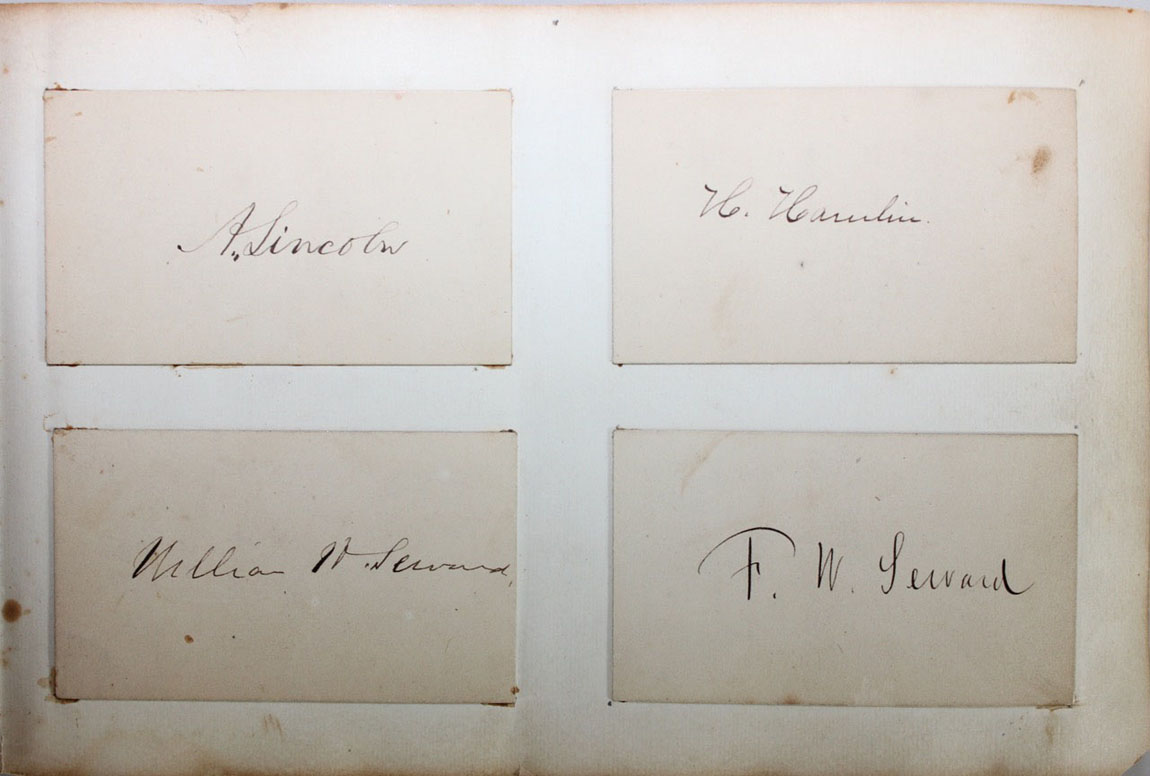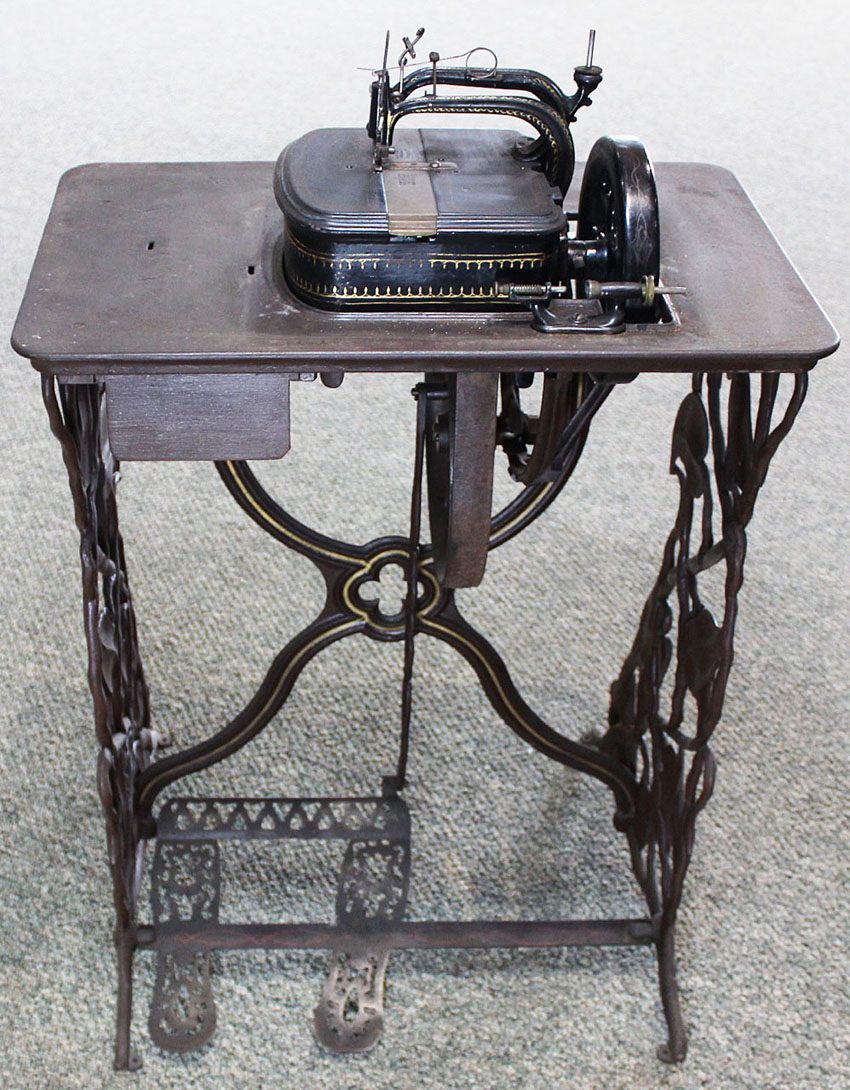Review And Onsite Photos By Rick Russack,
Catalog Photos Courtesy Daniel Buck Auctions
LISBON FALLS, MAINE — Daniel Buck is relatively new to the Maine auction scene but not new to the business. He’s been involved for more than 40 years as a dealer, auctioneer and appraiser, including several appearances on the Antiques Roadshow. He has been selling here in Lisbon Falls since last November and, in addition to a decorative and fine arts sale just completed, the company runs specialized auctions for various categories. The lead item in its October 24 sale was an album of Civil War-era autographs. Buck did his homework on it and thought it would do well, and it did. The surprise of the day, as it turned out, however, was a rare Singer sewing machine.
Buck said that when he first saw the sewing machine in the consignor’s home he almost passed it by. That is understandable as sewing machines are not thought of as top-of-the-line merchandise. Buck’s associate Bob Staples said it looked like an unusual one and might do well. After the sale, Buck said that he was glad he took Staples’ advice. Estimated at $400/600, it brought $17,050. Buck later learned that the machine, circa 1856, was the second model Singer produced, known as a “turtle back,” and was on an unusual decorative cast iron base with vines and leaves.
There were technical issues with the machine after it was released, and Singer recalled all that had been sold. The recalled machines were all destroyed and the bases smashed. Only six survive today. The buyer told Buck that he had been prepared to spend substantially more money for it.
Isaac Singer patented his sewing machine in August of 1851. That patent was contested by Elias Howe, who had patented a sewing machine in 1846. Howe eventually won his lawsuit against Singer, but Singer prospered. Singer’s machine was an immediate success; not only was the machine superior to anything on the market, but a few years later Singer devised a “hire-purchase” plan. It was, perhaps, the first installment payment plan and allowed women to own the machine for $5 a week.

The top lot of the day was an autograph album with 228 signatures of Civil War-era leaders. It included President Lincoln, Secretary of State William Seward, other cabinet officers, admirals, generals and supreme court justices. It achieved $55,000.
The company rapidly became the largest maker of sewing machines in the world, winning a gold medal at the Paris World’s Fair in 1855. Singer was a flamboyant figure, driving around in a specially designed carriage drawn by six horses. Married more than once, he fathered more than 20 children and left them all large sums of money in his will.
The Civil War-era autograph album on offer was consigned by a doctor from Vassalboro, Maine. It contained 228 autographs on standard-sized cards and attained $55,000. It had been assembled by William E. Kettles, who during the war years, was a telegraph operator in Washington, D.C. He earned himself a footnote in the history of the war by having been the telegraph operator on-duty when General Weitzel telegraphed Secretary of War Stanton with the news that Richmond had fallen to Union forces, a prelude to the end of the war. It was April 3, 1865.
President Lincoln saw the historic message moments later. It would seem that Kettles had an eye for history as he obtained the signatures of just about every person of note who passed through Washington during the war years. Most of the signatures were from Northerners, but the album included a document signed by Jefferson Davis and also included the signature of Robert E. Lee. It included signatures of supreme court judges, congressmen and senators, Edward Stanton, Andrew Johnson, Kit Carson, George Armstrong Custer, Hannibal Hamlin and William Seward. Buck used the Internet to verify the authenticity of the signatures and develop an estimate of the album’s value.
The album was bought by Wolf Spring, a collector from Rhode Island. Spring said that he had cut short a European vacation, having flown back from Germany the night before the auction so that he could bid in person. He told Antiques and The Arts Weekly that he has been collecting for about 30 years and that his main collecting interest is World War II material and photographica. He’s clearly right about his interest in photographs: Buck’s sale included 11 lots of photographs, many in gutta percha cases, and Spring bought them all. He said that in some instances the gutta percha cases were worth more to him than the photographs.
For the most part, painted furniture in the sale was not expensive. As one would expect, the best piece brought the best price. It was a very attractive stepback cupboard with a reddish-pumpkin painted surface. There were two arched panel doors each with six panes of glass, three drawers in the base, over two-paneled doors. It sold for $3,300, a reasonable price for this cupboard.
Other pieces of furniture were good buys. A grain-painted, two-door hanging cupboard brought $440. A cupboard with a single paneled door, in grey paint, finished at $137, and an architectural corner cupboard with a nine-panel glass door over a base with a paneled door achieved only $220. Doing well, was an early tall case clock made by Frederic Wingate of Augusta, Maine. The case was grain painted and ebonized, topped with pierced fretwork and three brass finials. The painted dial depicted a fox, chicken and fruit. Numbering on the dial was in both Roman and Arabic numerals. It was clearly labeled, identifying the Augusta, Maine, maker. The dial was dated 1807 and numbered 37. Numbers as high as 287 appear on Wingate clocks. This one sold for $4,950.

The surprise lot of the auction was this “turtle back” Singer sewing machine. It was Singer’s second model, made in 1856, and due to technical difficulties, all that had been sold were recalled and destroyed. Only about six are known to survive, and this one sold for $17,050.
Wingate was a prolific clock maker, possibly trained in Massachusetts before moving to Augusta in 1803. In addition to tall case clocks, he made banjo clocks and mirror clocks. His label indicated that he was also a silversmith and watchmaker. According to John Delaney, Wingate’s dials were made by Spencer Nolen, of Boston.
Buck’s sale had several other interesting items. A 13-inch Crown Vienna Art Nouveau vase with molded girls heads went out at $880. An Edison Triumph cylinder phonograph with two horns earned $467, and a very folky tin squirrel cage having a large rotating wheel ended up at $770. A full-bodied 29-inch running horse weathervane with a solid head, attributed to J.W. Fiske, was a bargain, reaching only $550.
Daniel Buck ran a fast-paced auction, selling more than 100 lots an hour. He was not able to accept Internet bidding but will be able to for future sales. After the sale, he said he was satisfied with the sale. “Good things brought good prices. Things need a little something extra these days and some of our stuff had that. It was a good crowd and the stuff we’re getting is better and better. We have some good specialized sales coming up and I feel the market is good — better than it was not too long ago.”
All prices reported include the buyers’ premium.
For additional information, www.danielbuckappraisals.com or 207-407-1444.



